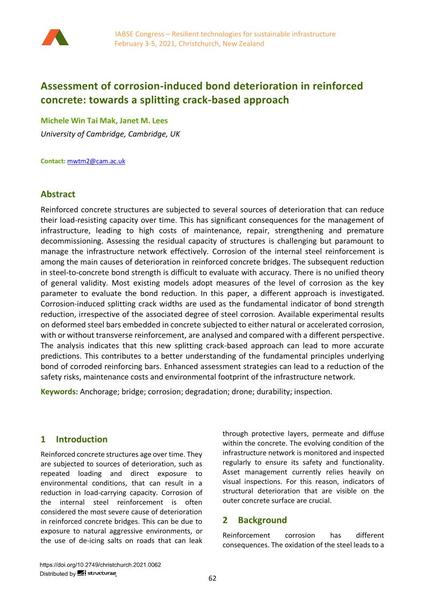Assessment of corrosion-induced bond deterioration in reinforced concrete: towards a splitting crack-based approach

|
|
|||||||||||
Bibliografische Angaben
| Autor(en): |
Michele Win Tai Mak
(University of Cambridge, Cambridge, UK)
Janet M. Lees (University of Cambridge, Cambridge, UK) |
||||
|---|---|---|---|---|---|
| Medium: | Tagungsbeitrag | ||||
| Sprache(n): | Englisch | ||||
| Tagung: | IABSE Congress: Resilient technologies for sustainable infrastructure, Christchurch, New Zealand, 3-5 February 2021 | ||||
| Veröffentlicht in: | IABSE Congress Christchurch 2020 | ||||
|
|||||
| Seite(n): | 62-69 | ||||
| Anzahl der Seiten (im PDF): | 8 | ||||
| DOI: | 10.2749/christchurch.2021.0062 | ||||
| Abstrakt: |
Reinforced concrete structures are subjected to several sources of deterioration that can reduce their load-resisting capacity over time. This has significant consequences for the management of infrastructure, leading to high costs of maintenance, repair, strengthening and premature decommissioning. Assessing the residual capacity of structures is challenging but paramount to manage the infrastructure network effectively. Corrosion of the internal steel reinforcement is among the main causes of deterioration in reinforced concrete bridges. The subsequent reduction in steel-to-concrete bond strength is difficult to evaluate with accuracy. There is no unified theory of general validity. Most existing models adopt measures of the level of corrosion as the key parameter to evaluate the bond reduction. In this paper, a different approach is investigated. Corrosion-induced splitting crack widths are used as the fundamental indicator of bond strength reduction, irrespective of the associated degree of steel corrosion. Available experimental results on deformed steel bars embedded in concrete subjected to either natural or accelerated corrosion, with or without transverse reinforcement, are analysed and compared with a different perspective. The analysis indicates that this new splitting crack-based approach can lead to more accurate predictions. This contributes to a better understanding of the fundamental principles underlying bond of corroded reinforcing bars. Enhanced assessment strategies can lead to a reduction of the safety risks, maintenance costs and environmental footprint of the infrastructure network. |
||||
| Stichwörter: |
Brücke Dauerhaftigkeit Korrosion Ankerblock Bauwerksprüfung Drohne
|
||||
